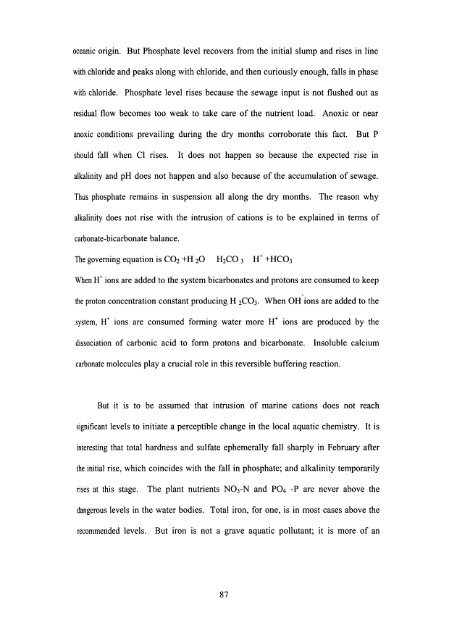Salinity Intrusion and Seasonal Water Quality Variations in the Tidal ...
Salinity Intrusion and Seasonal Water Quality Variations in the Tidal ...
Salinity Intrusion and Seasonal Water Quality Variations in the Tidal ...
Create successful ePaper yourself
Turn your PDF publications into a flip-book with our unique Google optimized e-Paper software.
ocearnc ongm, But Phosphate level recovers from <strong>the</strong> <strong>in</strong>itial slump <strong>and</strong> rises <strong>in</strong> l<strong>in</strong>e<br />
with chloride <strong>and</strong> peaks along with chloride, <strong>and</strong> <strong>the</strong>n curiously enough, falls <strong>in</strong> phase<br />
with chloride. Phosphate level rises because <strong>the</strong> sewage <strong>in</strong>put is not flushed out as<br />
residual flow becomes too weak to take care of <strong>the</strong> nutrient load. Anoxic or near<br />
anoxic conditions prevail<strong>in</strong>g dur<strong>in</strong>g <strong>the</strong> dry months corroborate this fact. But P<br />
should fall when Cl rises. It does not happen so because <strong>the</strong> expected nse In<br />
alkal<strong>in</strong>ity <strong>and</strong> pH does not happen <strong>and</strong> also because of <strong>the</strong> accumulation of sewage.<br />
Thus phosphate rema<strong>in</strong>s <strong>in</strong> suspension all along <strong>the</strong> dry months. The reason why<br />
alkal<strong>in</strong>ity does not rise with <strong>the</strong> <strong>in</strong>trusion of cations is to be expla<strong>in</strong>ed <strong>in</strong> terms of<br />
carbonate-bicarbonate balance.<br />
The govern<strong>in</strong>g equation is CO2+H 20 H2CO 3 H+ +HC03<br />
When H+ ions are added to <strong>the</strong> system bicarbonates <strong>and</strong> protons are consumed to keep<br />
<strong>the</strong> proton concentration constant produc<strong>in</strong>g H 2C03. When OH ions are added to <strong>the</strong><br />
system, H+ ions are consumed form<strong>in</strong>g water more H+ ions are produced by <strong>the</strong><br />
dissociation of carbonic acid to form protons <strong>and</strong> bicarbonate. Insoluble calcium<br />
carbonate molecules play a crucial role <strong>in</strong> this reversible buffer<strong>in</strong>g reaction.<br />
But it is to be assumed that <strong>in</strong>trusion of mar<strong>in</strong>e cations does not reach<br />
significant levels to <strong>in</strong>itiate a perceptible change <strong>in</strong> <strong>the</strong> local aquatic chemistry. It is<br />
<strong>in</strong>terest<strong>in</strong>g that total hardness <strong>and</strong> sulfate ephemerally fall sharply <strong>in</strong> February after<br />
<strong>the</strong> <strong>in</strong>itial rise, which co<strong>in</strong>cides with <strong>the</strong> fall <strong>in</strong> phosphate; <strong>and</strong> alkal<strong>in</strong>ity temporarily<br />
rises at this stage. The plant nutrients N03-N <strong>and</strong> P04 -P are never above <strong>the</strong><br />
dangerous levels <strong>in</strong> <strong>the</strong> water bodies. Total iron, for one, is <strong>in</strong> most cases above <strong>the</strong><br />
recommended levels. But iron is not a grave aquatic pollutant; it is more of an<br />
87

















